Chevrolet
Impala Front Brake Pads Replacement Guide
How to change the front disc brake pads
on a 10th generation 2014-2018 GM Chevy Impala including part numbers.
By Paul B. Michaels Author & Photographer Auto Mechanic Since 1989 |
||
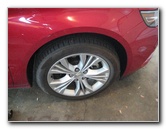 2014 Impala Front Wheel |
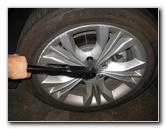 Slightly Loosen Lug Nuts |
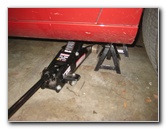 Raise Front of Car |
| This
automotive maintenance tutorial was specifically written to assist
owners of the tenth generation (2014, 2015, 2016, 2017 and 2018) GM
Chevy Impala in changing the front disc brake pads and lubricating
the caliper slider pins. Owners of other General Motors vehicles such as the Malibu, Cruze, Camaro, Sonic, Spark, Volt, Corvette, Trax, Equinox, Traverse, Tahoe, Suburban, SS Sedan, Bolt, Colorado, Silverado, Buick Verano, Regal, LaCrosse, Cascada, Encore, Envision, Enclave, Canyon, Sierra 1500, Terrain, Acadia, Yukon, Savana, ATS, CTS, XTS, CT6, XT5, SRX and Escalade may also find these DIY instructions to be helpful. A few compatible replacement sets of new front brake pads with their part numbers are as follows: ACDelco 17D1421CH, Wagner QC1159, Monroe CX1421, Akebono ACT924, Bosch BE924H and Raybestos PGD1421C. The tools and other items needed to complete this procedure include a lug nut wrench, a floor jack, two jack stands, a 14mm socket, a 3/8" drive ratchet, an "F" or "C" clamp, a 17mm wrench or pliers and a tube of brake caliper grease. |
||
|
|
||
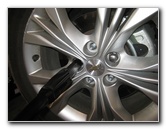 Spin Off 5 Lug Nuts |
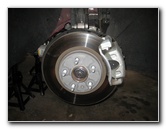 Rotor, Bracket & Caliper |
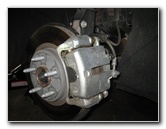 Front Brake Caliper |
| The first two steps
are to park the car on a level surface and turn off the ignition. Engage the emergency / parking brake and place wheel chocks on both sides of the rear tires to prevent the vehicle from moving. Slightly loosen the five lug nuts on the front wheel by turning them counterclockwise with the tire iron. Raise the front of the car with the floor jack and securely support it with at least two jack stands. I prefer to work on one side of the vehicle at a time to keep three wheels on the ground for extra safety. Spin off the 5 lug nuts and set them aside in a safe place. Remove the front wheel to reveal the rotor, bracket, caliper and suspension. The brake caliper is held in place to the bracket by two bolts located on the back side of the caliper. The bolt heads face in towards the engine bay. |
||
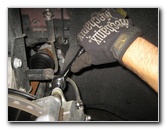 Loosen Top Caliper Bolt |
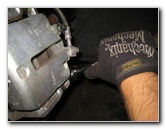 Loosen Bottom Caliper Bolt |
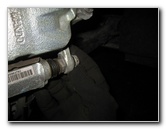 Spin Out Lower Bolt |
| Loosen the top
caliper bolt by turning it clockwise (as seen from the outside of the
vehicle) with the 14mm socket and a 3/8" drive ratcheting wrench. Then loosen the bottom 14mm bolt by turning it clockwise (as seen from the outside of the car). |
||
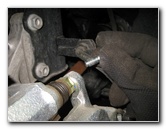 Remove Upper Bolt |
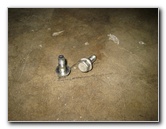 Two 14mm Bolts Removed |
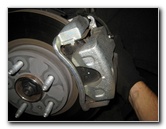 Pull Off Brake Caliper |
| Spin out the two
caliper bolts and set them aside in a safe place. Pull the brake caliper off the old pads and out of the bracket. |
||
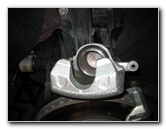 Rest Caliper On Suspension |
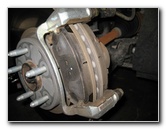 Old Brake Pads Exposed |
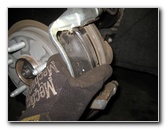 Remove Old Brake Pads |
| Carefully rest the
caliper on the suspension or suspend it from the spring with a bungee cord. Try to avoid bending, kinking or stressing the rubber brake fluid hose. Pull the old inner and outer brake pads out of the caliper bracket. |
||
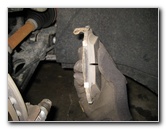 Wear Bar - Top Inner Pad |
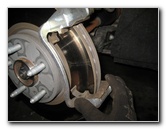 Replace Pad Abutment Clips |
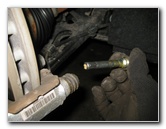 Caliper Slider Pins |
| Make a mental note
of where the wear indicator or "squeal" bar is located on the old pads. On this 2014 Impala, the wear indicator bar was situated at the top of the inner brake pad. If your replacement pads included new hardware, pull the old pad abutment or "anti-rattle" clips out of the top and bottom of the bracket. Apply a thin layer of brake caliper grease to the new pad abutment clips where they will come in contact with the bracket or the new pads. Install the new pad abutment clips in to the top and bottom of the bracket. In order for the caliper to operate smoothly, the two caliper slider pins or "guide bolts" need to be well lubricated. Pull the caliper slider pins out of their rubber dust boots. |
||
|
|
||
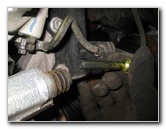 Lubricate & Replace Pins |
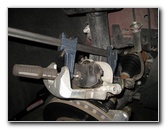 Attach "F" Clamp To Piston |
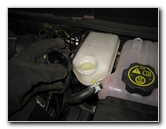 Twist Off Reservoir Cap |
| Apply some
synthetic high temperature brake parts
lubricant grease to the smooth part of each caliper slider pin
before pushing them back in to their rubber dust boots. In order for the caliper to fit over the thicker new brake pads, the piston needs to be pushed back in to the caliper. Attach the "F" or "C" clamp to the caliper and use the back of an old brake pad to evenly distribute the pressure across the piston. Move to the right rear area of the engine bay and twist off the brake fluid reservoir cap in the counterclockwise direction. Removing the reservoir cap will allow the brake fluid to more easily travel back through the lines when you compress the piston. |
||
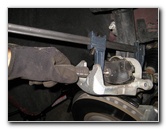 Compress Caliper Piston |
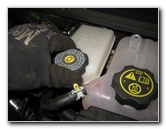 Replace Brake Fluid Cap |
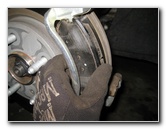 Install New Outer Pad |
| Slowly turn the "F"
clamp handle in the clockwise direction until the caliper piston is just
about flush with the rubber dust boot surrounding it. Try to avoid pinching or damaging the rubber dust boot surrounding the piston. Since brake fluid is hygroscopic (absorbs moisture from the air), replace the reservoir cap as soon as possibly by twisting it on in the clockwise direction. Thoroughly clean off the brake rotor, caliper bracket, brake caliper assembly and the lug nut studs with brake parts cleaner spray. Don't use compressed air or blow with your mouth to clean off the brake parts since inhaling brake dust can be harmful to your health. Brake dust may be carcinogenic (cancer causing) if inhaled. Apply a thin layer of brake parts lubricant to any area where there is metal to metal contact such as the outer lip of the caliper piston. Do not apply brake caliper grease to the friction surface of the new pads.
To remove the existing rotors and install new ones, remove the Torx T30 set screw and remove the two bolts on the rear of the caliper bracket that attach it to the steering knuckle. Then loosen the old rotor with a rubber mallet, pull it off, and slide the new one in its place. |
||
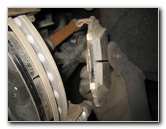 Wear Bar - Top Inner Pad |
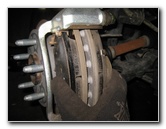 Push Pads Against Rotor |
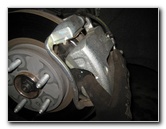 Lower Caliper Over Pads |
| I recommend buying
the ACDelco 17D1421CH brake pads
since they have excellent reviews on Amazon. Install the new brake pads in to the bracket with the wear indicator bar situated at the top of the inner pad. Push the two pads together until they are flush against the rotor. Carefully lower the caliper over the new pads and in to the bracket. |
||
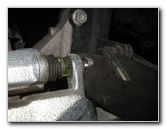 Spin In Top Bolt |
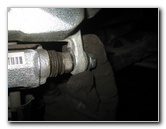 Replace Bottom Bolt |
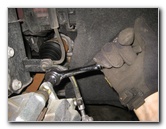 Tighten Counterclockwise |
| Line up the bolt
holes in the caliper with their corresponding bolt holes in the slider pins
within the bracket. Spin in the two caliper bolts a few turns by hand in the counterclockwise direction to prevent them from becoming cross threaded. |
||
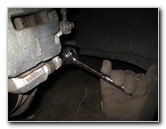 Tighten 14mm Caliper Bolt |
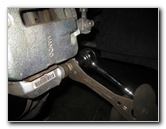 17mm Wrench - Hold Pin |
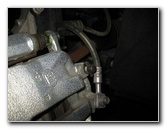 Rubber Valve Cap |
| Tighten the two
caliper bolts by turning them counterclockwise with the 14mm socket and a
3/8" drive ratchet to just past hand tight or about 25 lb-ft of torque. If the caliper slider pin turns as you are attempting to tighten the caliper bolts, hold the pins in place with a 17mm wrench or a pair of pliers. Double check that the two caliper bolts are tight before moving on to the next steps. |
||
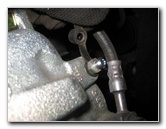 Brake Fluid Bleeder Valve |
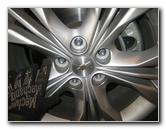 Replace Front Wheel |
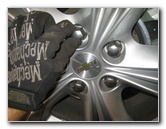 Spin On 5 Lug Nuts |
|
Double check that the two caliper bolts are tight before moving on to the next steps. If your brake pedal has previously felt soft or spongy, the brake fluid might be contaminated with water or the brake lines may contain some air bubbles. It would be best to bleed the brake lines at this time in order to flush out the old fluid and replace it with new DOT 3 brake fluid. For more on this topic, check out my Brake Line Fluid Bleeding With An Assistant DIY Guide or alternatively the Brake Line Fluid Bleeding With A Power Bleeder Guide. The brake fluid bleeder valve is located underneath a rubber cap on the back side of the caliper just below the top caliper bolt. Replace the front wheel and spin on the 5 lug nuts by hand in the clockwise direction to prevent them from becoming cross threaded. |
||
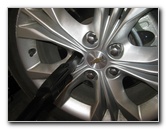 Slightly Tighten Clockwise |
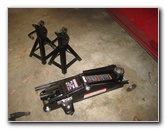 Lower Car From Jack Stands |
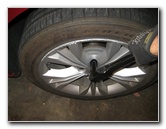 Torque To 110 lb-ft |
| Slightly tighten
the five lug nuts in a "criss cross" or "star" pattern with the tire iron. Carefully lower the car from the jack stands by using the floor jack. Continue tightening the lug nuts in the clockwise direction in a "criss cross" or star pattern to about 1/4 to 1/3 turn past hand tight or 110 lb-ft of torque. It would be best to use a torque wrench or an electric impact wrench with a torque stick to make sure that the lug nuts are properly tightened. Sit in the driver's seat of the car and firmly pump the brake pedal a few times to restore the brake line pressure. Check the brake fluid in the reservoir and verify that it is at the proper level. If it is low, pour in some new DOT 3 fluid. To break in your new front brake pads, just drive normally for the first few hundred miles while trying to avoid any hard or "panic" stops which may glaze over the new pads and cause them to become noisy and/or not perform as well. It's also a good idea to regularly check your driveway, garage or parking spot for drops of fresh brake fluid which may indicate a leak, check the brake fluid level in the reservoir and also verify that the lug nuts are still tight. Don't forget to record the brake pad change in your car's service records. For more, check out all of my
2014-2018 Chevrolet Impala DIY Repair & Maintenance Guides. |
||
| If you found this guide to be helpful,
please consider making a small donation by clicking on the PayPal.com
"Donate" button located to the right of this paragraph. Thank you!
(Note: I am not a registered charity. Donations are not tax deductible.) |

